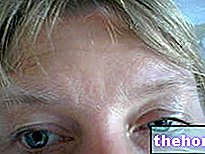
The trigeminal is actually made up of a pair of nerves that branch off symmetrically to both the right and left in the head; however, in most cases the disorder affects only one side of the face (unilateral), most commonly the right side. Rarely, patients with trigeminal neuralgia have bilateral pain. The seizures are of short duration (from a few seconds to 1-2 minutes), can arise without warning and, sometimes, can occur in rapid succession; the associated pain is often described as an electric shock or a lash, while a dull background pain may persist in the intervals between attacks. In affected people, even mild stimulation of specific areas of the face (trigger points) can trigger a painful attack Seizures can be triggered by vibrations or contact with the cheek (such as when shaving or applying make-up), while brushing, eating or talking. Due to the intensity of the pain, some patients may avoid these daily activities, as they fear an impending attack. The exact cause of trigeminal neuralgia is not always understood, but there is, in most cases, a contact between the nerve. trigeminal and a blood vessel, which runs nearby. This proximity exerts a compression on the nerve end, which determines a functional alteration for which the trigeminus sends abnormal signals to the brain. Less commonly, neuralgia can be caused by a tumor compressing the nerve of the same name. Trigeminal neuralgia can occur as a consequence of aging or can be due to other pathological conditions: diseases of the central nervous system (such as multiple sclerosis), brain injury, trauma, infections or other abnormalities. Neuropathy is rare in people under the age of 40 years and occurs more frequently in female subjects. Living with trigeminal neuralgia can be difficult, especially if it affects the quality of life: the intensity with which it occurs can be disabling and can also lead to depression, with feelings of extreme sadness or despair that last a long time. Fortunately, many treatment options are available to effectively manage trigeminal neuralgia.The physician should determine which treatment is best suited to the patient's clinical picture, if the condition is primary, or treat the underlying disease if the disorder is secondary to an "other condition.

Three branches run from each trigeminal ganglion:
- Upper branch (ophthalmic nerve, V1) - innervates the eye, forehead, scalp and front of the face;
- Middle branch (maxillary nerve, V2) - innervates cheek, side of nose, jaw, upper lip, palate, teeth and gums;
- Lower branch (mandibular nerve, V3) - innervates the mandible, lower, lower lip, mouth and tongue. It also stimulates the movement of the muscles involved in biting, chewing and swallowing (it is a mixed sensory and motor nerve).
Neuralgia can affect one or more branches of the trigeminal nerve. The maxillary branch is most frequently involved, while the ophthalmic branch is the least affected termination.
.The main symptom of trigeminal neuralgia is severe, stabbing pain that comes on suddenly and localizes to specific areas of the face. The painful crisis almost always involves only one side of the face and can typically affect the lower jaw, upper jaw, cheek and less often the eye. and forehead.
Trigeminal neuralgia can present with a "tingling" or numbness sensation in the face, which turns into a burning, extreme, or electric shock-like pain. A seizure can last anywhere from a few seconds to two minutes, but can recur in rapid succession throughout the day. Some people experience constant dull pain even in the refractory periods, which separate the different episodes of acute trigeminal neuralgia. However, the symptoms may disappear completely and not recur for months or years.
Typical trigeminal neuralgia (TN1) usually has the following characteristics:
- The pain is sudden, intermittent, sharp and stabbing or similar to an electric shock.
- You may experience regular spasms of pain for days, weeks, or months for each episode.
- The pain may affect a limited area of the face or may spread to neighboring areas.
- The frequency of seizures increases over time. In severe cases, the pain can occur hundreds of times a day.
- Attacks of pain rarely occur during the night when the patient is sleeping.
A less common form of the disorder, atypical trigeminal neuralgia (TN2) is characterized, instead, by a less intense but throbbing and continuous pain, or by a dull burning sensation. This manifestation sometimes occurs sporadically, can last a day or more, and is associated with mild but persistent pain between attacks. This form of trigeminal neuralgia responds less positively to treatment than the type 1 form.
.
Compression of the trigeminal nerve. Evidence suggests that in 80-90% of cases, the cause of neuralgia is contact between the nerve and a nearby blood vessel. This proximity can create pressure on the trigeminal nerve near where it enters the brain stem (the lowest part of the brain that merges with the spinal cord); Repeated compressions erode the protective coating around the nerve (ie the myelin sheath), altering the normal conduction of nerve impulses.
Structural causes. Other causes that can affect the trigeminal nerve are damage to its myelin sheath, caused by:
- Abnormalities of blood vessels (such as an aneurysm)
- Cysts or tumor formations;
- Diseases such as multiple sclerosis, a long-term condition affecting the central nervous system;
- Post-herpetic complications (Herpes Zoster infections).
temporomandibular etc. The neurological examination allows to define exactly which branches of the trigeminal nerve are involved. Before confirming the diagnosis of trigeminal neuralgia, further investigations allow to exclude other pathologies that can cause facial pain. Furthermore, these analyzes are important in distinguishing the classic form. secondary form of trigeminal neuralgia caused by another condition (called symptomatic trigeminal neuralgia). If this second case is diagnostically confirmed, then treatment must focus on the underlying disease.
Other disorders, such as post-herpetic neuralgia and cluster headache, can cause similar facial pain. Injuries to the trigeminal nerve (resulting from dental surgery, stroke or facial trauma) can also produce a neuropathic disorder characterized by dull, burning and persistent pain. Because of the overlapping symptoms, and the variety of conditions that can cause facial pain, making the diagnosis is often difficult; nevertheless, finding the exact cause of neuralgia is essential to define the correct therapeutic approach.
Other conditions that need to be excluded are:
- Multiple sclerosis;
- Infection or breakage of a tooth
- Migraine;
- Pain in the lower jaw;
- Temporal arteritis;
- Traumatic injury of a cranial nerve (post-traumatic neuralgia);
- Facial pain with no known cause (idiopathic).
Most patients undergo magnetic resonance imaging (MRI) to rule out cancer or multiple sclerosis as a cause of pain. This scan can clearly show whether the trigeminalis is compressed by a blood vessel, cyst, or neoplastic formations. Magnetic resonance angiography (MRA) can also help define the etiology of trigeminal neuralgia more clearly: nerve compression, aneurysm, and any other abnormalities or malformations along the course of the nerve end.
Continued: Trigeminal Neuralgia - Care and Treatment




























